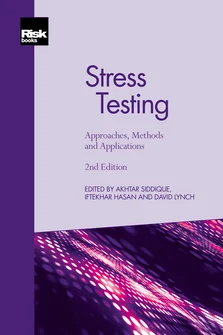Stress-test Modelling for Loan Losses and Reserves
Michael Carhill and Jonathan Jones
Foreword
Introduction
Response to Financial Crises: The Development of Stress Testing over Time
Stress Testing and Other Risk Management Tools
Econometric Pitfalls in Stress Testing
Stress-testing applications of Machine Learning Models
Four Years of Concurrent Stress Testing at the Bank of England: Developing the Macroprudential Perspective
Stress Testing for Market Risk
The Evolution of Stress Testing Counterparty Exposures
Liquidity Risk: The Case of the Brazilian Banking System
Operational Risk: An Overview of Stress-testing Methodologies
Peacetime Stress Testing: A Proposal
Stress-test Modelling for Loan Losses and Reserves
A New Framework for Stress Testing Banks’ Corporate Credit Portfolio
EU-wide Stress Test: The Experience of the EBA
Stress Testing Across International Exposures and Activities
The Asset Market Effects of Bank Stress-test Disclosures
An Alternative Approach to Stress Testing a Bank’s Trading Book
Determining the Severity of Macroeconomic Stress Scenarios
Governance over Stress Testing
The widespread use of macroeconomic and financial factors in the quantitative models that banks use to forecast their credit losses has been an important development. The financial crisis of 2007–09, and the associated recession, underscored the need for banks to incorporate economic and market conditions into their retail and wholesale credit risk models to produce credible stress loan-loss estimates. Prior to the financial crisis, few financial institutions estimated stressed credit losses, although stress testing for market risk and banking book interest rate risk was routine. Since the crisis, a number of banks have determined that models capable of estimating credit losses conditional on economic scenarios were necessary for enterprise-wide capital planning and stress testing.
Several supervisory and regulatory developments also have accentuated this trend. First, the largest US banks that are subject to the advanced internal ratings-based (AIRB) approach of Basel II are required to conduct a cyclicality stress test in Pillar 1 and a forward-looking stress test of credit risk as part of the Internal Capital Adequacy Assessment Process (ICAAP) in Pillar 2. Second, the Basel
Copyright Infopro Digital Limited. All rights reserved.
As outlined in our terms and conditions, https://www.infopro-digital.com/terms-and-conditions/subscriptions/ (point 2.4), printing is limited to a single copy.
If you would like to purchase additional rights please email info@risk.net
Copyright Infopro Digital Limited. All rights reserved.
You may share this content using our article tools. As outlined in our terms and conditions, https://www.infopro-digital.com/terms-and-conditions/subscriptions/ (clause 2.4), an Authorised User may only make one copy of the materials for their own personal use. You must also comply with the restrictions in clause 2.5.
If you would like to purchase additional rights please email info@risk.net











